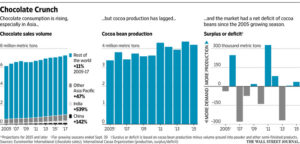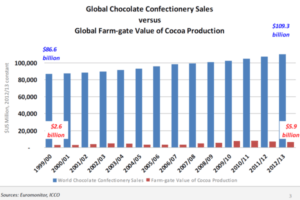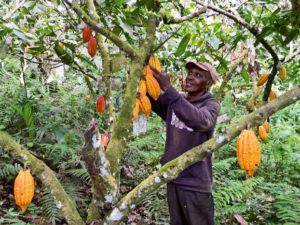Is the world running out of chocolate?

Amongst concerned chocolate aficionados, “Chocopalypse” is an embellished term used to encapsulate the very real threat that climate change poses to global cocoa supplies. With chocopalypse looming closer, how does the American chocolate giant Mars, one of the world’s largest cocoa buyers, secure its business in a world that is rapidly running out of chocolate?
The undeniable impact of climate change on big food production is already evident. Cocoa is one of the cash crops most affected by climate change, threatening the future of chocolate companies like Mars. Most of the world’s cocoa today comes from West Africa (67%), mainly Ghana and the Ivory Coast, followed by South East Asia (25%) and then the Americas (8%) [1]. Cocoa farming supports 5 million smallholder farmers whose livelihoods depend on the crop [2]. There are two big shifts affecting Mars’s core business streams. Extreme changes in temperature and precipitation will mean that cocoa yields from farms will continue to decrease yearly and by 2050, some of these regions might not be suitable for cocoa growth at all [3]. Exacerbating this is the rising cocoa demand, expected to rise by 3% annually, fueled by increased consumption in India and China and outstripping supply entirely by 2020 [4].
Source : The Wall Street Journal, “The race to save cocoa”, http://www.wsj.com/articles/chocolate-makers-fight-a-melting-supply-of-cocoa-1452738616
In order to sustain its business model, Mars has outlined a three-fold strategy. The first step is to improve yields on existing land by providing scientific and technological agricultural support for farmers. This not only sustains cocoa supply for Mars, but also incentivizes farmers with higher incomes and ensures that cocoa farming thrives as a financially secure, long-term livelihood choice for them. To aid this, Mars has set up a research center that looks into cocoa breeding, farming methods and other yield-improving practices [5]. Especially in countries like Ivory Coast, where climate change awareness is low and where government guidelines are non-existent, it becomes critical to supply farmers with tools, techniques and training to cultivate high-quality yields, a knowledge transfer facilitated by its many Cocoa Development Centers (CDC’s) [6]. This initiative is expected to triple yields in 3-5 years [7]. Secondly, Mars is also using technology and innovation as a competitive advantage, working with IBM and the US government to map the cocoa genome to develop more resilient strains of cocoa that will thrive in extreme weather [8]. Lastly, Mars has committed to certifying their entire supply chain by 2020 to be sustainable[9]. Beyond the cocoa supply chain, Mars has also pledged to reducing its carbon-footprint across their entire supply chain, becoming carbon neutral by 2040 [10].
While these efforts are commendable, there are several other avenues that Mars can explore further.
Diversify Sourcing Locations : The first is to future-proof their supply chain. There are predictive technology systems today that forecast climate change patterns and pinpoint the new regions that will be better suited for cocoa production, allowing Mars to re-engineer their sourcing strategy [11]. To an extent, this is why most chocolate companies, including Mars are looking to expand cocoa sources in Asia, across Indonesia, Malaysia and Vietnam [12].
Credit and Capital : Companies need to ensure that expansion into Asia does not come at the cost of clearing primary forests, where after the palm oil crisis, governments have issued strict deforestation policies. If land needs to be rehabilitated, then Mars will need to develop financing programs that will sustain farmers as they rehabilitate used land for new cocoa plantations. Research shows that cocoa yield is still only at 10% of what the theoretical yield is and this gap is largely attributed to lack of farmer resources [13]. If Mars can develop new business models that allow for lending credit and providing capital to their farmers, it will promote more land rehabilitation and more mechanization of farming practices, leading to more sustainable cocoa communities.
Source : Euromonitor, ICCO
Increase Consumer Prices : To reward farmers and support broader farmer financing, on the other end of the supply chain, Mars and the chocolate industry at large could look at increasing consumer prices.
Technology assisted training: Mars can also use technology to intensify information flow to and between farmers to build more collective intelligence on climate change and agricultural best practices, beyond the in-site CDC’s. There is a growing number of tech social enterprises that develop mobile agricultural apps that provide farmers with real-time meteorological information and training on pests, fertilizers and soil composition to train farmers and continue to increase yields in a cost effective way, especially in markets where such information is not easily circulated or available.
Economies of supply chain scale : Lastly, one of the agricultural best practices that mitigate climate change effects on cocoa production is agroforestry which recommends planting cocoa along with other crops that provide shade[14]. Can Mars utilize their broader raw material supply chain to centralize farms across other key product ingredients like coffee? This would provide centralized sourcing units, creating economies of scale and improve productivity at the same time. Using the existing partnerships on big food sustainability, they could even form farming alliances with other consumer goods companies who could also participate in the initiative.
Source: CIRAD, Agricultural Research for Development, http://www.cirad.fr/en/research-operations/research-results/2011/evaluating-cocoa-agroforestry-systems-to-design-new-cropping-systems
Word Count – 785
Endnotes
- Mars : Caring for the future of cocoa, http://www.marsgcc.com/global/sustainability/raw-materials/cocoa, accessed on November 2, 2016
- Ibid
- O.Nieburg, “Hot chocolate: How will industry protect its key commodity from climate change?”,April 28, 2015, http://www.confectionerynews.com/Commodities/Climate-change-and-cocoa-Chocolate-firms-action-to-temperature-rise, accessed on November 3, 2016
- Mars : Our Cocoa Policy, http://www.marsgcc.com/global/about-us/policies-and-practices/cocoa-policy, accused on November 2, 2016
- Mars : Cocoa, http://international.mars.com/global/about-mars/mars-pia/our-supply-chain/cocoa.aspx, accessed on November 2, 2016
- Ibid
- Ibid
- Ibid
- Ibid
- Ibid
- “Predicting the Impact of Climate Change on the Cocoa- Growing Regions in Ghana and Cote d’Ivoire”, Climate Change Agriculture and Food Security, International Center for Tropical Agriculture, September 2011, http://www.eenews.net/assets/2011/10/03/document_cw_01.pdf, accessed on November 1 2016
-
O. Nieburg, ‘We cannot let Indonesia fail’: Mars stresses Asia’s importance in meeting future cocoa demand, 29 April 2015, http://www.confectionerynews.com/Commodities/What-is-the-future-of-cocoa-growing-in-Asia, accessed on November 2 2016
- Mars : Cocoa, http://international.mars.com/global/about-mars/mars-pia/our-supply-chain/cocoa.aspx, accessed on November 2, 2016
- ”Assessment of Climate Change Impacts on Cocoa Production and Approaches to Adaptation and Mitigation: A Contextual View of Ghana and Costa Rica”, World Cocoa Foundation, 2015, accessed on November 2 2016






I am glad to see that Mars’ has established a three-fold strategy to become more sustainable, especially as they work with other stakeholders, like the government, to research and leverage technology to optimize production yields. The direct reduction of their carbon footprint is a highly visible sustainability effort that benefits the broader ecosystem.
I would be curious to know if Mars’ initiatives to develop more resilient cocoa strains as a competitive advantage means that they will vertically integrate upstream to be able to exclusively capture the production and cost benefits. If they are just introducing new strains to suppliers, the suppliers could use the new cocoa plants for other customers as well. Obviously, this would benefit the planet the most if production yields increased across the board, but it would not be consistent with Mars’ business model of creating a competitive advantage based on minimizing input costs. Additionally, I am concerned with the potential option/suggestion to use data to identify more ideal climates for cocoa sourcing. This would not actually help reduce the impact of climate change but simply just help Mars’ derisk their supply chain. Their operating model would only be aligned with their business model of maximizing revenue, rather than in combination with their sustainability goals.
While I agree with the idea of diversifying sourcing locations, one of the main issues with growing cacao trees is that they generally only grow 10-20 degrees north and south of the equator. This already-limited area of growth is being restricted even further by climate change. Scientist might explore genetically altering or interbreeding different cacao tree strains to produce new species that could handle these changing conditions. Additionally, Mars might look to see if climate change has converted previously non-ideal cacao growing areas into environments that the trees can now sustain.
Additionally, you mentioned how Mars could benefit from economies of supply chain scale. I completely agree that Mars should look into partnering with other chocolate companies like Nestle, who are suffering from the same climate change challenges, to reduce supply chain costs. They might even explore partnerships with companies shipping other agricultural products (e.g., coffee beans, spices). This would protect cacao farmers from revenue cuts and chocolate consumers from price hikes.
Mars has an enormous footprint on the cocoa industry. However, unlike its key competitors – Nestle and Mondelez International – I get the sense that Mars has been less of a leader in adoption of method towards sustainability. They were far behind Cadbury and Kit Kat on Fairtrade certification, and often do not market their other initiatives. One could argue that the fact that they are a privately held company unlike their competitors, they have less pressure to present their sustainability agenda. That being said, they certainly are doing a large amount of work in other kinds of sustainability with regards to consumer portion control, using less energy etc, but again don’t market it that overtly. In order to truly be making a dent, Mars should consider finding a meaningful and motivating way for their consumers to care about and drive their climate change agenda. Only the economics of that force can help the industry elevate past token pilot programs.
Fascinating post! Increasing consumer prices sounds like a great way to support broader farmer financing. Perhaps making this more tangible to consumers, explaining the price increase publicly as going directly to farmers to help them with sustainable farming practices could be a way to increase awareness and show Mars is a company prioritizing sustainability. I am intrigued that Mars is committing to making their entire supply chain sustainable by 2020, but am hesitant to laud these efforts as I am not sure what barometers they are using to ensure these changes are making a positive impact on the environment, and if these barometers are reliably evaluated, as reports have suggested auditing processes for confirming sustainability standards are met are often unreliable. Also, while primarily focusing on supply, I am worried Mars is missing how they can adjust their manufacturing and distribution processes to use less water and less energy overall (and more renewable energy) to make an even bigger positive change in their contribution to our world’s climate change issues.
Great research! I was aware that cocoa production is unlikely to keep up with our current levels of demand but had not thought through so many options. I particularly like the final proposal, the economies of supply chain scale. Unfortunately, as you mentioned, cocoa is not the only crop in the equatorial region that is suffering from the effects of climate change. Coffee is another widely consumed food item from that region that is at risk of environmental shifts, and many other foods for both global and local consumption are affected. One of the best ways to ensure agricultural sustainability is to diversify the crop mix, which will strengthen the soil and increase mineral content. It will also help local farmers diversify their streams of income. Finally, Mars could partner with non-competitors and still accomplish better sustainability practices. If Mars were to partner with large coffee producers (e.g., Illy, Starbucks) or fruit producers, which do not compete directly with the chocolate aisle, all the companies would jointly benefit from shared sourcing.
Thanks for the interesting post! I was very impressed by the other avenues that you mentioned to mitigate the impact on climate change. It seems that the agriculture industry is affected by the climate change a lot, but actually there are still lots of are for improvement. I’m thinking that if available, maybe the agriculture industry should have regular meetings and collaboration to invest in new product developments. As we don’t have enough time now to face the potential risk of climate change, if agriculture companies don’t work together to focus on development, I’m afraid that the speed of development might not be able to catch up with the speed of the destroying rate of our earth. The other point I’m interested in is the information disclosure. Should companies disclose relevant information to let consumers know that every purchase directly leads to some impact on the climate change? Though it might have some conflicts with companies’ profits, but as companies with social responsibilities, I do believe that information disclosure would be a good way to show the willingness to solve problems.
Mars has done a very good first step with his three-fold strategy to diagnostic and provide solution to the threat that climate change puts on its natural resources. I’m impressed they are trying to solve the problem at its core by investing R&D money into developing a more sustainable way of growing cacao.
That being said, what I like a lot about your proposal is the idea to invest their technical and financial capabilities in emerging markets in order to diversify their source of raw materials. Not only would it benefit the company because it would reduce its dependance on a few areas of the world but it would also create positive social returns to communities which is a goal that Mars seems to be concerned with. If Mars can leverage its experience to help build a more sustainable agriculture in less developed countries in the world, it should also help to slow down the effects of climate change which are currently expected to grow exponentially as the emerging markets intensify their agriculture practice. That way Mars would create value both for itself, for its partners and for the environment in general.
Before reading this article, I was unaware how much investment Mars is making the cocoa supply chain all the way down to the farmer level. I previously viewed Mars as an end user as a commodity product. Can you imagine the maker of Doritos, Frito Lay, investing in corn farmers and setting up corn research centers? I suppose they might, though, if it looked like the majority of the corn supply chain might collapse without intervention and disrupt their ability to make enough Doritos. Whether Mars is making these investments for sustainability’s sake or the sake of its bottom line or the sake of the subsistence farmers in their network is almost a moot point – Mars stands to benefit if the supply chain remains intact regardless.
Excellently researched and written article, Paro. I agree that Mars’ three-pronged strategy is making a dent in the effect that cocoa harvesting causes on climate change; but, there is much more that can be done to combat its effects. Of the potential solutions you mentioned, I think that increasing consumer prices, striving for economies of supply chain scale, and the credit/capital suggestions are the most viable. Given this crucial moment in human history, we need to start looking seriously at scaling down our harvesting of commodities like cocoa, palm oil, and coffee. One way to do this would be by artificially decreasing supply to drive up prices, thereby decreasing consumption. If you match this practice with the financing programs you mentioned, perhaps Mars would not see such an impact on their bottom line. Finally, there are a lot of TOM-esque benefits to be gained from integrating the cocoa and coffee supply chains. Perhaps with further study, Mars will be able to implement some of the best practices you mentioned to maintain their profitability, and help to save our planet.
What an awesome post Parvathy! I am a bit surprised at how little Mars is doing to be proactive about solving this problem. Most of their solutions seem to be about mitigating their own risk (diversifying their sources, creating sustainable financing for farmers) and sourcing to take advantage of economies of scale seems a bit weak. It would be great to see them make efforts within their own plants to minimize climate impact as well as incentives farmers to exercise sustainable practices. It’s a nice step that they are doing research in this area, but I think they will need to create some type of incentive for farmers to adopt any of their recommended practices.